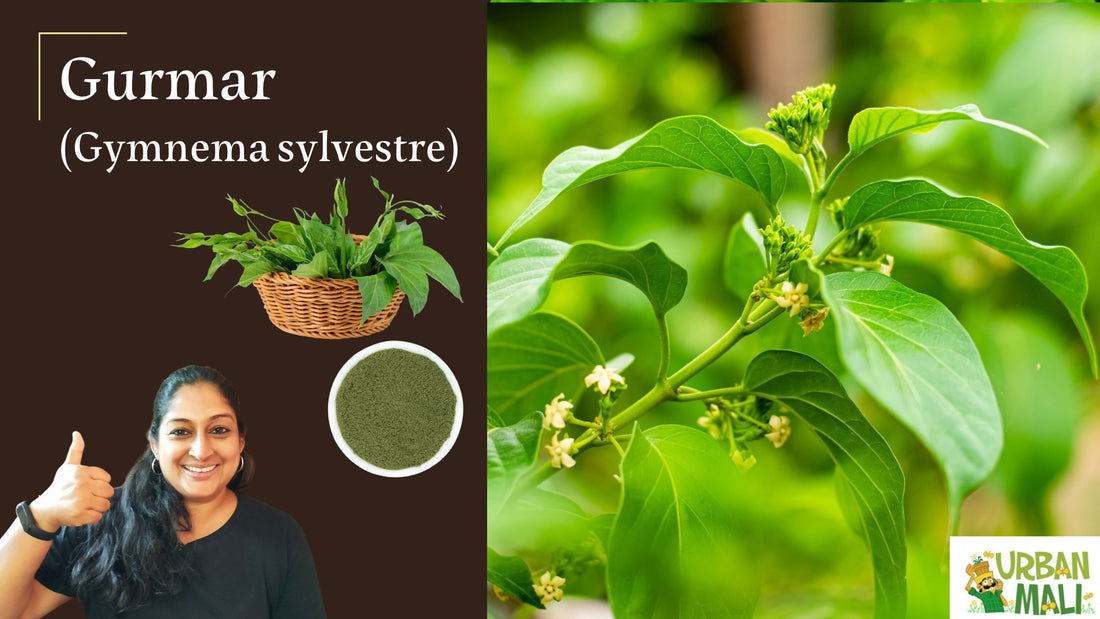Gymnema Sylvestre belongs to the family Asclepiadaceae which includes plants commonly known milkweeds. Gymnema Sylvestre is a herbaceous perennial plant found in tropical regions including India, Sri Lanka and Africa.
Gurmar or Gymnema sylvestre has gained popularity over the years due to its ability to reduce sugar cravings and boost metabolism. This plant also helps in managing blood pressure and cholesterol levels.
Gurmar is a herb native to India and Sri Lanka. The leaves of gurmar contain gymnemic acids, which are responsible for its medicinal properties.
Common names include Gurmar, Madhunashini, and Sugar destroyer.

Phytochemistry of Madhunashini
Gymnema Sylvestre is used in Ayurveda to treat diabetes. Gymnemic acid is one of the active phytochemicals found in the leaves of Gymnema Sylvestra. This compound lowers blood glucose levels and increases insulin sensitivity. Gymnemasaponin is another important phytochemical present in Gymnema. It reduces cholesterol and triglycerides.
It is believed that gurmar contains saponins, flavonoids, tannins, glycosides, alkaloids, triterpenes, steroids, sterols, amino acids, carbohydrates, proteins, vitamins, minerals, enzymes, polysaccharides, essential oils, volatile oil, fatty acid, etc. These compounds provide various health benefits such as lowering blood glucose level, reducing inflammation, improving digestion, preventing cancer, boosting immunity, treating diabetes, etc.
The main active ingredient of gurmar is gymnemic acid, which is an oligosaccharide compound containing five monosaccharide units: D-mannose, L-rhamnose, D-glucose, D-galactose, and D-xylose. Gymnemic acid is found in many plants including gurmar, karela, aloe vera, etc.

Health Benefits of Gurmar
Gymnema Sylvestre is one of those herbs that you just don't see advertised much anymore. But it used to be quite common in Ayurvedic medicine, especially for diabetes sufferers.
In fact, it was one of the most popular herbals in India for over 2000 years. And now, scientists are discovering some pretty amazing health benefits of gymnemic acid, the compound found in Gymnema Sylvestre.
1) Lower Blood Glucose Levels
2) Improve Insulin Sensitivity
3) Reduce Cholesterol and Triglycerides
4) Boost Immune System
5) Treat Diabetes
6) Prevent Cancer
7) Promote Digestion
8) Protect Against Radiation Damage
9) Help With Weight Loss
10) Relieve Constipation
11) Treat Hepatitis B
12) Fight Heart Disease
13) Enhance Memory
14) Increase Energy Levels
15) Lower Blood Pressure
16) Treat Depression
17) Treat Anxiety
18) Prevent Alzheimer’s

How to grow Gymnema slyvestre
1. Grow Gymnema Sylvestre Indoors
You can grow gymnema indoors in a pot or window sill. To grow gymnema outdoors, find a sunny spot in your yard and dig a hole large enough to accommodate the root ball. Place the root ball in the ground so that the roots are exposed to air. Water regularly until the soil around the root ball dries out completely.
2. Harvest Gymnema Sylveste Regularly
Once the leaves begin to turn yellow, harvest the entire plant. Cut the stems just above the base of the leaf cluster. Remove the leaves individually and place them in a glass jar. Cover the jar with cheesecloth and let sit overnight.
3. Dry Gymnema Sylvestere
Dry the leaves in a food dehydrator set to 115 degrees Fahrenheit. Let the leaves dry for 24 hours before storing them in an airtight container.
4. Use Gymnema Sylvestore as Tea
Use 1 teaspoon of dried gymnema per cup of boiling water. Steep for 5 minutes and strain. Drink daily.
Next step
Gardener services
Landscaping services
Online nursery
Organic pesticides and fertilizers
Extra reading
10 Medicinal plants to grow at home
Herbs that you can grow at home
Dodda Davana (Artemisia nilagirica)
Nela bevu (Andrographis paniculata)
Happy Gardening!
Dr. Vandana K.

